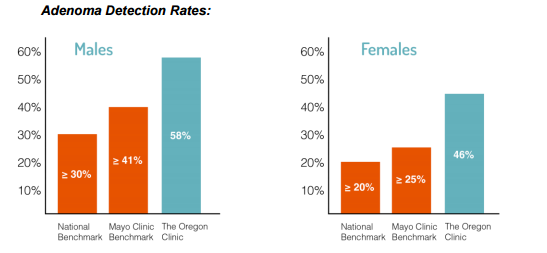The bad news: Colon cancer affects 1 in 20 Americans and is the second deadliest cancer. The most common symptom is no symptoms at all. The good news: Screening colonoscopies work. When diagnosed early, the five year survival rate is 90%. The even better news: There's a team of 51 gastroenterologists at The Oregon Clinic who are outperforming national benchmarks (and even the Mayo Clinic) in their colonoscopy services. During Colon Cancer Awareness Month this March, gastroenterologists across the nation are reminding everyone: colonoscopies save lives. Colonoscopies not only screen for cancer, but can also prevent cancer. During the past decade, rates of colon cancer have decreased by 25%, in large part thanks to the widespread use of colonoscopies. If everyone age 50 and older were screened regularly, 6 out of 10 deaths from colorectal cancer could be prevented.
“More than 50,000 people in the United States are dying every year from colon cancer and we want to change that,” emphasizes Dr. David Grunkemeier, MD, gastroenterologist with The Oregon Clinic. “Every Oregonian should be talking to their doctor about getting a colonoscopy at age 50. If they have a family history of colon cancer, they should be talking to their doctor much earlier than that. We now know that the rate of colon cancer is increasing in younger people.”
The Oregon Clinic's 51 gastroenterologists are some of the very best in the Pacific Northwest, performing an astounding 28,000 colonoscopies last year. There are four key benchmarks set by the Gastroenterology Quality Improvement Consortium for quality colonoscopy. In all four, The Oregon Clinic's team of doctors far outperforms national benchmarks, and even surpasses those of the Mayo Clinic.
So how do they do it?
As simple as it may sound, work ethic, collaboration, and commitment to constant improvement.
"What really sets us apart is our commitment to ongoing education with each and every physician in our program – no one is resting on their laurels," explained Dr. Anne Wang, MD, gastroenterologist with The Oregon Clinic. "We talk about what it means to perform a quality colonoscopy. We’re all willing to learn and incorporate new techniques to enhance quality in our colonoscopies."
The Oregon Clinic’s data doesn't represent just a few super stars, elevating the results for the group.
"We know all our physicians exceed these standards, but we want every single physician to continue to exceed their own personal benchmarks,” says Dr. Wang.
What should you look for when choosing a doctor for your colonoscopy?
- How good they are at spotting potential cancer
- The most important measure to look for is a physician's adenoma detection rate, or ADR. This tells you how good a physician is at identifying and removing adenomas – the higher percentage, the better they are. An adenoma is a benign (non-cancerous) tumor that over time can progress to become malignant (cancerous). The National Benchmark ADR in men is 30%; The Oregon Clinic's detection rate is 58%. In women, the National Benchmark ADR is 20%, and The Oregon Clinic performs at 46%.

- Slower is better
- The slower the withdrawal time, the better. You want your physician to be thorough, and that means slowly checking the colon for pre-cancerous polyps as they withdraw the scope. Slower withdrawal times lead to potentially more pre-cancerous polyps found, which lowers the patient’s risk of cancer. The National Benchmark is at least 6 minutes; The Oregon Clinic's specialists average 10 minutes.
- A really low perforation rate
- A perforation, or making a hole in the colon, is one of most serious complications that can occur during a colonoscopy and would likely require surgical repair. The Oregon Clinic has an incredibly low 0.03% perforation rate, while the National Benchmark is 0.20% or less. That means only 3 out of every 10,000 colonoscopies has a perforation at The Oregon Clinic, while the national benchmark is about 20 out of every 10,000 colonoscopies.
- A low bleed rate
- The post-polypectomy bleed rate is the percentage of time significant bleeding occurs after a polyp is removed during a colonoscopy. Bleeding may happen immediately, or may be delayed from hours up to 14 days. The Oregon Clinic has a 0.2% post polypectomy bleed rate, with the National Benchmark being 1% or less. Although bleeding after a colonoscopy is typically easily managed, serious complications can occur if left untreated.
“If we can increase the number of people getting colonoscopies, we will save lives through detecting and preventing colon cancer,” reminds Dr. Jeffrey Duman, MD, gastroenterologist at The Oregon Clinic. “Tell your family and anyone you care about to prioritize this potentially lifesaving test.”
About The Oregon Clinic
The Oregon Clinic is the largest private specialty physician practice in Oregon. Approximately 350,000 patients receive respectful, compassionate care from our nearly 250 providers in more than 30 specialty areas each year. Founded in Portland in 1994, The Oregon Clinic is committed to delivering the highest quality patient care, practicing evidence-based medicine, and providing leadership for the healthcare community. We collaborate with primary care physicians and use a team approach to address health conditions at 59 specialty clinic locations across northwest Oregon and southwest Washington. Call 503-935-8000 or visit www.oregonclinic.com for more information.